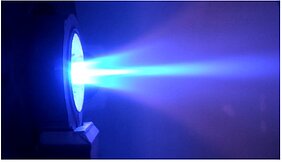Space Colloquium Würzburg
10.03.2022Invitation to the Space Colloquium Würzburg titled "Advanced Electric Propulsion Systems for Groundbreaking Missions: Developments at IRS" by Prof. Dr. Georg Herdrich on the 10th of March 2022 at 17:00. This event is supported by Elite Network of Bavaria (ENB) and ESA_Lab@ZfT.
IRS-developments related to advanced electric space propulsion (EP) are highlighted. To a signi¬fi-cant ex¬tent these developments are enabled by the strong peripheral systems at IRS (vacuum system(s), high power energy supply with power plant, facilities) in connection with extensive de-velop¬ments in plas¬ma dia¬gnostics and modeling. Hence, such elementary infrastructural corner¬stones are depicted as well. Exemplary developments are discussed: Among them are systems such as IEC-based thrusters and atmos¬phere breathing EP systems (ABEP) as well as high power EP (150 kW) as steady state applied-field MPD thrusters. The impact of generative manu¬factur¬ing processes is assessed. This is of con¬cern for thermal arcjets where the technology enables advantages on level of mass and in¬creased efficiency. Pulsed plas¬ma thrusters developed at IRS can compete with well-established Russian PPTs on level of their thrust effi¬ciencies. Hence these PPTs pro¬vide robust, reliable and cheap EP systems, that fit into the concept of Cube¬Sats. GREENcube will be high¬light¬ed, a mission equipped with a cluster of IRS-PETRUS PPT thrusters. Its launch will be in summer 2022. Finally, a bridge is built con¬necting the EP technologies with advanced mission types: Those missions have disruptive elements as they are linked to man¬ned Mars, ISRU, and VLEO missions.
Interested persons can dial in for the presentation at https://go.uniwue.de/space-colloquium.
Curriculum Vitae Prof. Dr. Georg Herdrich: Prof. Herdrich has a doctorate in aerospace from the University of Stuttgart. At IRS, he is responsible for re-entry and EP. He has participated in pro¬jects as the re-entry capsule MIRKA, temperature measurement system for the Japanese HOPE-X (JAXA, Kawasaki), and the development of the measurement system PYREX-KAT38 (X38) (NASA, ESA, DLR). He was PI for three ATD instrumentations for the ESA capsule EXPERT, and one of the PIs of the ATV “Jules Vernes” airborne observation. The University of Rome GreenCube Satellite for which his team developed a PETRUS PPT system (ESA, ASI) will be launched in June 2022. The 100-kW applied field MPD thruster SX3 is a reference for the start-up NSS. In the project DISCOVERER an advanced ABEP system is developed. The FET open “MEEST” aims at the development of MHD-systems en¬abling the magnetic influence to plasmas for heat flux mitigation for spacecraft entering an atmosphere. He has more than 300 conference papers to his name and more than 120 contributions in reviewed journals/ books. He covers lectures as Unconventional Space Propulsion, Plasma Technology, Re-Entry Technology, and Electric propulsion. Since 2007, he has served as visiting assoc. prof. at University of Tokyo and since 2010 as Adj. Assoc. Prof. at Baylor Univ., USA. Awards include several NASA Awards and the Du Pont Plunkett Award (with Dr. A. Nawaz, NASA, M. Schlipf, Elring-Klinger) for a Teflon® helix propellant feeding system for the PPT ADD-SIMPLEX. In 2006-2012 and from 2021 he has been serving as delegate of Germany in UN’s working group, “Nuclear Power in Space” (NPS). He participated in the development of the UN’s safety framework for NPS. Between 2010 and 2014 he was the European lead for RTO task group, “Gas-surface-interaction.” He serves as editor for the CEAS Space Journal. In 2012 he obtained his habilitation.







